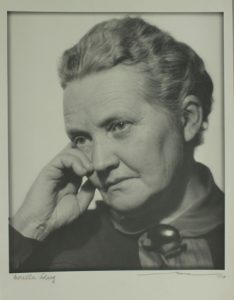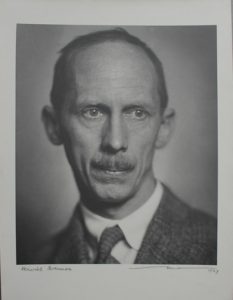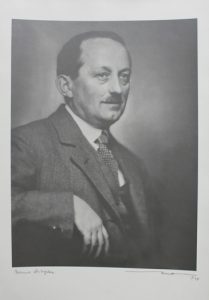
Otto Dix (1891–1969)
Rothaarige Frau (Damenporträt), 1931 / Red-haired Woman (portrait of a lady), 1931
The First World War and its effects changed the way the painter Otto Dix saw. He developed his own critical realism, combining old master technique with biting social criticism. Thus he became one of the most important protagonists of New Objectivity. The main focus of his works was on the themes of the big city and the demimonde. Here, the glory and misery of the twenties are reflected in a concise manner. The sitter illustrates this contradiction with her sequined dress, the pale face and the torn and skinny body.

Hans Grundig (1901–1959)
Bildnis Gerda Laube, 1925 / Picture of Gerda Laube, 1925
Gerda, what do you think?
You look so much thoughtful?
What happened?
The view from outside: Haiku of Mona, 10, Pablo Neruda elementary school, Chemnitz

Ernst Ludwig Kirchner (1880–1938)
Chemnitzer Fabriken, 1926 / Factories of Chemnitz, 1926
In 1926, Kirchner looks out over the city centre of Chemnitz, over the large factories of the Sächsische Maschinenfabrik (formerly Richard Hartmann AG.) and Germania (formerly J.S. Schwalbe und Sohn) to the towers of the town hall. The dome of the city’s central market hall, opened in 1891, appears in the center of the picture. The painter combines the buildings of the town hall, factories, churches and the crafts school into a narrowly selected section. Kirchner lived in Chemnitz from 1890 to 1901 and attended grammar school here, as did the artists Karl Schmidt-Rottluff and Erich Heckel, who also grew up in Chemnitz.
Albert Renger-Patzsch (1897–1966)
Treppenhaus, undat. / Stairway, n. d.
Albert Renger-Patzsch was a photographer of the Neue Sachlichkeit (New Objectivity). His work »Die Welt ist schön« (»The World is Beautiful«), published in 1928, became the basis of modern photography and earned him his artistic breakthrough. Some works from this work can be seen here. Albert Renger-Patzsch, who always used a large-format plate camera, shows in these photographs his new view of the world with his objective eye for details, structures, and surfaces. In 1944, a large part of his Essen archive was destroyed in a bombing raid. His photographs fill numerous illustrated books.








Józef Rosner (1892–1971)
Porträts der Mitglieder der Künstlergruppe Chemnitz, 1929 / Portraits of the Members of the Art Group Chemnitz, 1929
The Polish photographer Józef Rosner was born in Cieszyn in 1892 as the son of a Jewish father and a German mother. After an apprenticeship with the court photographer Karl Pitzner in Vienna, he went to Germany in 1910 and opened his own photographic studio in Chemnitz in 1925. He was especially well known in the field of portrait photography and was represented at photo exhibitions in and outside Germany. Due to discrimination by the National Socialists, Rosner left Chemnitz in 1936 and settled in Krakow.
The eight portraits of the members of the Chemnitz group of artists belong to the old stock of the Kunsthütte. In their clarity and formal restraint, the photographs convey an authentic image of the sitters.

Gustav Schaffer (1881–1937)
Selbstbildnis, 1926 / Self-Portrait, 1926
In clear forms the artist presents himself in his painting smock. This painting style will later be called “New Objectivity”. Before the restoration, dirt deposits, a yellowed varnish and over-painting severely affected the appearance. A decorative frame was also missing. Careful surface cleaning, removal of the yellowed varnish and over-painting produced the original layer of paint. Defects were retouched.
The missing decorative frame was supplemented by a new one. Original frames from other paintings of the artist served as a model.
Detlef Göschel, painting restorer

Karl Schmidt-Rottluff (1884–1976)
Mädchen, 1920 / Girl, 1920
A more than unusual portrait, at the same time a thoroughly color-painting experiment in the primary colors. These are also used in complementary contrasts. The figure is not captured by the almost pure surrounding colors, but merges with them. A young girl sits with her hands on her knees in a sunken gaze as if it were holding something. Numerous portraits were created in the first year of peace after the First World War, a moment of artistic self-reflection by Schmidt-Rottluff. In 1919 he married Emy Frisch, but his sister Gertrud could also have stood model (cf. “Der Besuch”, “The Visit”) could also have posed for the portrait. A comparable counterpart in style can be found in the ‘Galerie der Moderne’: the “Young Man with a Pipe”.

Karl Schmidt-Rottluff (1884–1976)
Am Belasee, 1932 / On Belasee, 1932
Every year in summer, the artist left his Berlin residence for several months to find peace, relaxation and inspiration on the coast. From 1932 to 1943, the Schmidt-Rottluff couple spent their summer stays in Rumbke on Lake Leba on the Baltic coast of Hinterpommern. Schmidt-Rottluff shows a seemingly untouched landscape, which is determined by the colours of the water, the horizon, the simple fishing boats, cage poles and the reeds growing on the shore. On the back of the painting the painter has captured the title Am Belasee (At the Lake Bela) and in doing so, consciously or accidentally, he has made a Lake Bela out of the Lake Leba by exchanging the consonants.
Karl Schmidt-Rottluff (1884–1976)
Steinschnitte, Arbeiten aus Horn, Holz, Papier, Metall und Textil, 1911–1953 / Stone carvings, works in horn, wood, paper, metal, and textiles, 1911–1953
The exquisite collection of handicraft works by Karl Schmidt-Rottluff, formerly owned by Dr. Victor and Hedda Peters, was in family possession for decades and presents the artist’s versatile talent in its extraordinary quality. With a total of 49 items, it includes stone carvings, works in horn, wood, paper, metal, and textiles. The Leipzig collector couple Peters supported the artist throughout his life by purchasing paintings. The collection was acquired by the Ostdeutsche Sparkassenstiftung together with Sparkasse Chemnitz.
Karl Schmidt-Rottluff (1884–1976)
Schmiedeeiserner Kerzenständer, vor 1943 / Wrought-iron Candlestick, before 1943
The candlestick takes a special position in the Schmidt-Rottluff work. It is unique and the largest piece of handicraft work. The artist recovered the candelabra from the ruins of his Berlin apartment in Bamberger Straße in March 1947. He had the candelabra transferred to Chemnitz, where it was restored by his brother Kurt in 1949.

